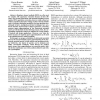Free Online Productivity Tools
i2Speak
i2Symbol
i2OCR
iTex2Img
iWeb2Print
iWeb2Shot
i2Type
iPdf2Split
iPdf2Merge
i2Bopomofo
i2Arabic
i2Style
i2Image
i2PDF
iLatex2Rtf
Sci2ools
DAC
1996
ACM
1996
ACM
A Sparse Image Method for BEM Capacitance Extraction
Boundary element methods (BEM) are often used for complex 3-D capacitance extraction because of their efficiency, ease of data preparation, and automatic handling of open regions. BEM capacitance extraction, however, yields a dense set of linear equations that makes solving via direct matrix methods such as Gaussian elimination prohibitive for large problem sizes. Although iterative, multipole-accelerated techniques have produced dramatic improvements in BEM capacitance extraction, accurate sparse approximations of the electrostatic potential matrix are still desirable for the following reasons. First, the corresponding capacitance models are sufficient for a large number of analysis and design applications. Moreover, even when the utmost accuracy is required, sparse approximations can be used to precondition iterative solution methods. In this paper, we propose a definition of electrostatic potential that can be used to formulate sparse approximations of the electrostatic potential ma...
BEM Capacitance Extraction | Capacitance Extraction | Computer Architecture | DAC 1996 | Sparse Approximations |
| Added | 08 Aug 2010 |
| Updated | 08 Aug 2010 |
| Type | Conference |
| Year | 1996 |
| Where | DAC |
| Authors | Byron Krauter, Yu Xia, E. Aykut Dengi, Lawrence T. Pileggi |
Comments (0)

